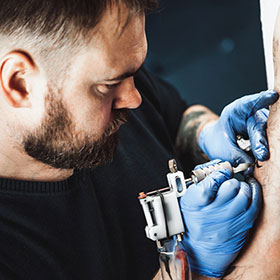Yes, bicep tattoos can hurt. The pain varies from person to person.
Some feel mild discomfort, while others experience more intense pain. Getting a tattoo is a personal decision, and understanding the pain involved is crucial. The bicep is a popular spot for tattoos because of its visibility and muscle mass. But the skin in this area can be sensitive.
Pain levels depend on individual pain tolerance, the tattoo’s size, and the artist’s technique. In this post, we’ll explore why bicep tattoos can hurt, what factors influence the pain, and how to manage it. Whether you’re considering your first tattoo or adding to your collection, this guide will help you prepare for the experience.
Bicep Tattoo Pain Levels
The inner bicep is more sensitive than the outer bicep. The skin is thinner and there are more nerves. This means more pain. The outer bicep has more muscle and fat. This makes it less painful. Most people feel a dull ache here. Some say it feels like a scratch.
Pain tolerance varies for each person. Some people have a high pain threshold. Others feel more pain. Hydration and rest can help reduce pain. Eating well before getting a tattoo is also important. Avoiding alcohol and caffeine can help too. These can make the skin more sensitive. Breathing deeply and staying calm can help manage pain. Distraction like music or talking can also help.
Common Pain Myths
Many believe bicep tattoos are very painful. This is not always true. Pain varies from person to person. Some feel a tickle. Others feel a sting. Location and size of the tattoo also matter. Smaller tattoos often hurt less. Big, detailed tattoos may hurt more. Tattoos on muscle can be less painful than on bone.
People have different pain thresholds. Some say their bicep tattoo did not hurt. Others say it was painful. Personal pain experiences can vary. Friends may share different stories. It is important to remember this. Everyone’s experience is unique.
Preparing For The Tattoo
Think about why you want the tattoo. Be sure of your choice. Confidence helps reduce stress. Talk to friends who have tattoos. They can share their experiences. Positive thoughts will make the process easier. Imagine the final result. It will look great.
Get a good night’s sleep. Rest is important. Eat a healthy meal before your session. Energy is needed. Stay hydrated. Drink water to keep your skin ready. Avoid alcohol and caffeine. They can make you nervous. Wear comfortable clothes. It helps you relax. Keep your bicep clean and dry. This helps the tattoo artist.
During The Tattoo Session
A tattoo artist will clean your bicep first. They will then outline the design. This may cause mild discomfort. The tattoo machine buzzes and vibrates. The needle feels like a pinch. Some spots might hurt more than others. The inner bicep can be more sensitive.
Take deep breaths. Relax your muscles. Talk to your artist. They can take breaks. Numbing creams might help. Wear comfortable clothing. Bring a friend for support. Listen to music or watch a video. Stay hydrated and eat before your session. This can help you feel better.
Aftercare Tips
Keep your new tattoo clean and dry. Use mild, unscented soap to wash it. Pat dry with a clean towel. Avoid rubbing the tattoo. Apply a thin layer of healing ointment. Do this for the first few days. Wear loose clothing to avoid irritation. Keep the tattoo out of direct sunlight. Avoid swimming pools and hot tubs. This helps to prevent infection.
Continue to keep the tattoo clean. Moisturize regularly with unscented lotion. Avoid scratching or picking at the tattoo. This can cause damage. The tattoo may peel or itch. This is normal. Do not expose the tattoo to the sun. Use sunscreen to protect it. The colors can fade if not protected. Stay patient. Tattoos take time to heal fully.
Pain Relief Methods
Topical anesthetics can help reduce pain. These creams numb the skin. Numbing creams are easy to apply. They work fast. Apply them before the tattoo session. They are safe for most people. Always follow the instructions. Consult a professional if unsure. Anesthetics make the process easier.
Natural remedies can also help. Ice packs reduce swelling and pain. Apply them for short periods. Aloe vera gel soothes the skin. It helps with healing. Deep breathing calms the mind. It reduces stress. Listening to music can distract from pain. These methods are gentle and effective.
Choosing The Right Artist
Check the artist’s portfolio. Look at their previous work. Make sure they have experience with bicep tattoos. Read reviews from other clients. Good reviews mean good work. Ask friends for recommendations. A trusted friend can guide you to a great artist. Visit the shop in person. See if it’s clean and professional. A clean shop means safe tattoos.
Prepare questions for the consultation. Ask about their experience. Ask how long the tattoo will take. Discuss the pain level. Know what to expect. Explain your design ideas clearly. Bring pictures if you have them. This helps the artist understand your vision. Listen to their advice. They know what works best. Feel comfortable with the artist. Trust is important for a good experience.
Personal Stories
Many people say bicep tattoos can be painful. Each person feels pain differently. Some feel a pinch, others a burn. The skin on the bicep is soft. This may cause more pain. Some enthusiasts suggest using numbing cream. This can help reduce discomfort. It is important to stay calm. Deep breaths help during the process. Aftercare is crucial too. Keep the area clean and moisturized. Avoid direct sunlight. Healing well ensures the best results.
Conclusion
Bicep tattoos can cause some pain, but it varies for everyone. Pain levels depend on individual pain tolerance and the tattoo’s complexity. Many find the discomfort worth the final result. Always choose a reputable tattoo artist for a smoother experience.
Preparation and aftercare can also help manage pain. Remember, tattoos are a personal journey. Take your time to decide if you’re ready for it. Ultimately, the choice is yours. Are you ready for the commitment?

